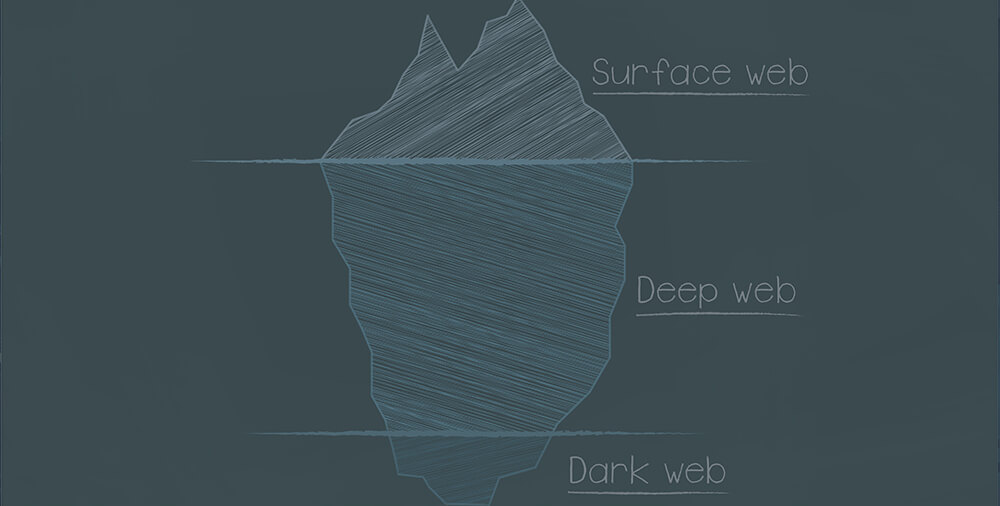The internet is made of up three parts: the surface web, the deep web, and the dark web. There are key characteristics that distinguish each part, but the differences are often poorly understood – especially when it comes to the connection with cybercrime. Here’s the difference between the surface web, the deep web, and the dark web, and what you need to know to help protect yourself online.
What Is the Surface Web?
The surface web is the public part of the internet. These sites are indexed by search engines such as Google and can be visited by anyone with an internet connection. When you’re looking at public websites that aren’t hidden behind a login, you are on the surface web.
What Is the Deep Web?
The deep web is part of the internet that is not indexed by search engines, which means you can’t find it by searching online. The content on the deep web can only be found using specific tools or websites.
Any time you visit content that requires a direct URL address or login to access, you are visiting the deep web.
Examples of the deep web include:
- Your private email account
- Your online bank account
- Your streaming accounts (such as Netflix or Hulu)
- Your personal social media accounts
- Paid content such as news subscriptions
- Pages not linked to by other pages that require the exact URL to access
You probably access the deep web all the time in your daily life. Deep web pages are simply made up of online content that can’t be found publicly and require special access to visit.
What Is the Dark Web?
The dark web is another part of the internet that cannot be found using search engines, but it also can’t be located using a standard web browser. It requires an anonymous browser to access, and encryption tools make it possible for websites to hide the identity of their creators and users.
There are many legitimate uses of the dark web, but its anonymity also makes it the perfect location for illegal activity.
Some uses for the dark web include:
- Illegal marketplaces that sell drugs, weapons, and other types of contraband.
- Marketplaces and forums that sell or leak consumer’s private information stolen via data breaches or social engineering. This information can be used for fraud and identity theft.
- Hacking forums and websites that provide tools and information needed to carry out cyber-attacks.
- Forums and websites used to organize other illegal activities including fraud, illegal pornography, and terrorism.
- Information and communications sites used by journalists, human rights activists and political dissidents who work in countries that are hostile to free speech.
- Free access to academic research.
Surface Web vs. Deep Web vs. Dark Web – Differences Explained
There are two major differences between the three parts of the internet: their size and accessibility.
Size
Each part of the internet differs in size:
- The surface web. If the internet is an iceberg, the surface web is only the part that sticks out of the water. This public part of the internet is just a fraction of the entire thing.
- The deep web. The largest part of the internet by far, the deep web lies below the surface and consists of the content that you need special access to find.
- The dark web. The dark web is the bottom part of the iceberg that descends into the depths of the ocean. Its inaccessibility makes it difficult to measure, but it is likely a small portion of the internet.
Accessibility
Each part of the internet also differs in accessibility:
- The surface web. This public part of the internet can easily be accessed by anyone with an internet connection.
- The deep web. This part of the internet requires special access, such as a private account login or a private link shared with the user.
- The dark web. Only users with an anonymous browser can access the dark web.
Risks of Accessing the Surface Web, Deep Web, and Dark Web
No matter if you’re on the surface web, deep web, or dark web, there are risks associated with getting online. Threats include malware, ransomware, data breaches, and phishing scams.
How to Help Keep Your Information Safe Online
Criminals may target your personal information to commit fraud, identity theft and other scams.
Here are some tips to help keep your information safe:
- Use strong and unique passwords for your online accounts.
- Enable multi-factor authentication on your accounts for an additional level of security.
- Use virtual private networks (VPNs) and anti-virus software to maintain privacy, anonymity and security online.
- Avoid clicking links, downloading attachments, and taking other actions on information received from unverified sources.
- Never give out your personal information online or share personal details on social media.
Bottom Line
No matter where you find yourself online, it’s important to take steps to help protect yourself and your personal information. To help keep you safe, IdentityIQ provides identity protection and credit monitoring services, including dark web scans that look for your personal information across thousands of sites on the dark web.
Deep Web vs. Dark Web FAQs
Is the deep web safer than the dark web?
The deep web may be safer than the dark web because it is harder for criminals to gain unauthorized access. However, the deep web is a popular target for criminals because of the valuable information it contains.
Can law enforcement track the dark web?
Law enforcement does track the dark web to look for criminal activity.
Which is bigger, the dark web or the deep web?
The deep web makes up the majority of the internet by a large margin.

